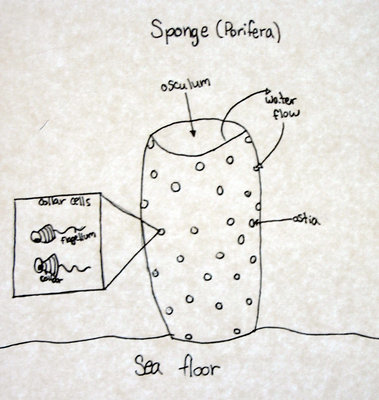

Pseudoceratina crassa, courtesy NOAA
Description
Sponges are the simplest of multi-cellular animals (2). They are invertebrates without any organs or tissues, but they do have a skeleton-like structure made up of spicules (calcium carbonate or silica shards) and/or spongin (protein material) (2). Some of the sponge's most unique and distinguishing features are the tiny pores, called ostia, covering its body along with the few larger holes, called oscula (2). Ostia act as inhaling pumps that have a vacuum effect on the surrounding water, pulling it into the complex series of canals inside the sponge's body. Through these canals, smaller pores act as filters to churn water through and take in nutrients to feed the sponge (6). Sponges can be quite small, but can also grow extremely large, up to approximately 3 meters in height and an inner volume large enough to contain a human being (2). Within the body of the sponge, there are unique cells called choanocytes, which pump water using their flagella and trap food with their sticky collar.
Habitat
A Sponge is a salt water, bottom-dwelling animal, which attaches itself to a solid surface where it may receive enough nourishment to grow and survive (2). However, how a sponge grows depends on whether they are an encrusting or a free-standing sponge (2). Encrusting sponges, like moss, tend to cover the surfaces of rocks (1). Free standing sponges on the other hand are a little more interesting, these sponges have a large amount of inner volume compared to their surface area and often grow to gigantic proportions (1,2). Both types of sponges however, are filter feeders and as such they grow most successfully in an area with a strong current (4). Therefore, sponges are most often found attached to marine reefs and are less common in shallow, sunny reefs (4). Sometimes however, sponges will grow on the body of another organism (4). This occurs because sponges contain toxic substances to discourage predators, and other marine animals will take advantage of this defense system (4). The sponge will serve as a protector for that organism, and in return the organism will give them a place to grow.
Adaptations to Environment
As marine environments grow, sponges are finding that they have continually more competition around them, so to ensure a place to grow a sponge will emit toxic substances into the water to scare off other organisms (5). In some cases however, sponges do not want to frighten off all the other marine animals. Some sponges will participate in symbiotic relationships with bacteria and algae where the sponge provides support and protection and the symbiont provides food for the sponge (5). The protection given by the sponge is usually achieved through the release of toxins, but in some cases may be found by sinking into the hard surface of corals and mollusks.(5) This will provide a solid wall of defense around the sponge, however it damages the reefs and causes the mollusks to die (5).
Reproduction
All sponges are hermaphroditic, meaning they can produce both eggs and sperm, but usually only act as either male or female during fertilization. Sponges can also reproduce both sexually and asexually (2). Asexual reproduction occurs when a fragment of a sponge is broken off by natural forces or by predators. The fragment floats in the current to a new location and grows into a clone of the parent sponge, with identical DNA (7). Sexual reproduction is more common among sponges and occurs when a sponge, utilizing its male properties, produces sperm into the water through the oscula. This sperm then swims through the water, finding its way towards a nearby sponge's egg, which it then fertilizes (6). This fertilized egg grows inside the parent sponge until it becomes a larva, at which time it is released from its parent and is transported by the current to a separate location where it will grow into an adult. Though they take only one role during fertilization, they may switch roles the next time they want to reproduce (7).
Summary
Sponges, despite being multi-cellular organisms, are extremely simple. They are covered in pores which suck water into internal cannals, in which nutrients are then extracted. This is known as filter feeding. Sponges are known for this fact as well as their hemaphroditic orientation (their ability to play the role of both male and female during reproductive activity.) To find a sponge, one must look in the bottom of a salt water body. Either an encrusting or a free-standing sponge may be found, but regardless of which species is discovered one must be aware of the sponge's defense mechanism of releasing toxic gases. If one can avoid these gases however, one may study the exciting and interesting organism that is the sponge.
Information on the Internet
- (1) Ocean Animals: Sponges
- (2) Bird, Jonathan. Sponges: the weird wonder of the seas
- (3) Enchanted Learning: Sponges
- (4) Campbell, Susie. Sponges- Phylum Porifera
- (5) Myers, Phil. Phylum Porifera (Animal Diversity Web)
- (6) Collins, Allen G. Porifera: Life History and Ecology (UCMP Berkeley)
- (7) Tree of Life Porifera




 Go to quick links
Go to quick search
Go to navigation for this section of the ToL site
Go to detailed links for the ToL site
Go to quick links
Go to quick search
Go to navigation for this section of the ToL site
Go to detailed links for the ToL site